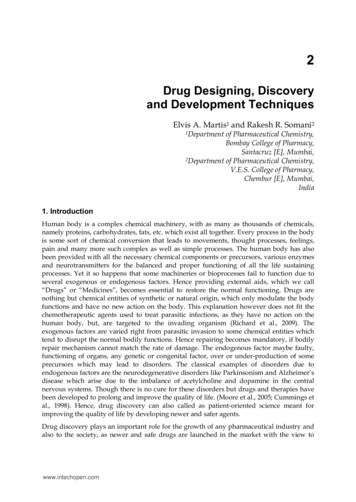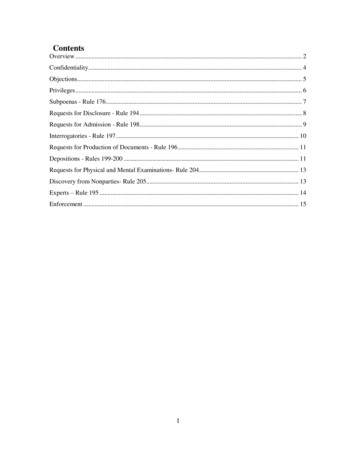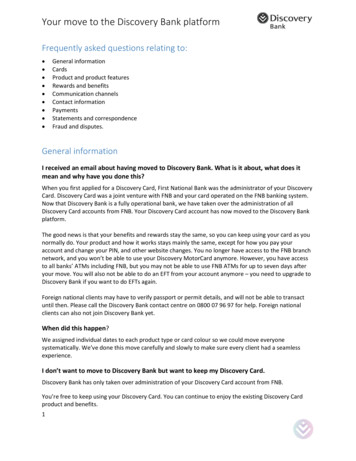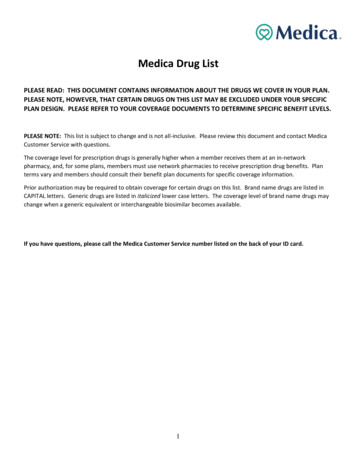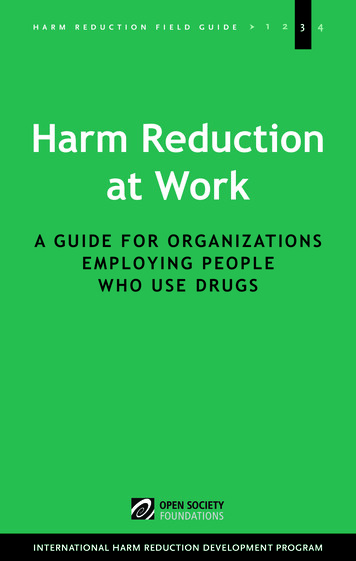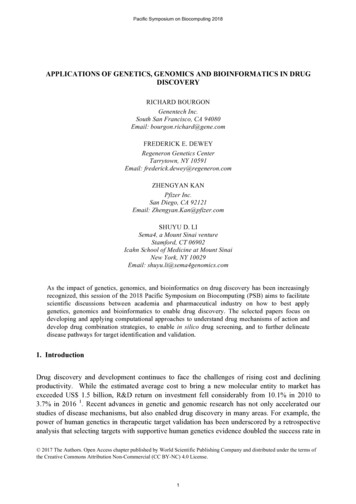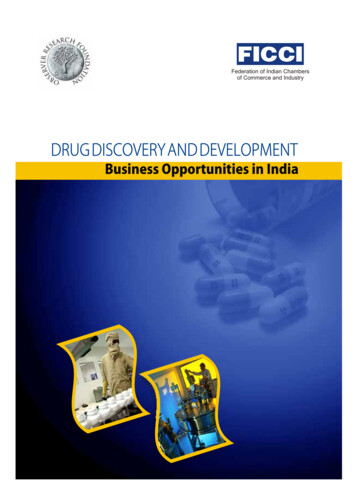
Transcription
DDinDRUG DISCOVERY INSIGHTSEVOTEC ANDCELGENE ENTERINTO DRUGDISCOVERY COLLABORATION FORNEURODEGENERATIVE DISEASESExclusive broad R&Dcollaboration based onEvotec’s iPSC platform
MissionDevelop novel therapies for a broad range of neurodegenerativediseases, based on Evotec’s unique patient-derived drugscreening platform induced pluripotent stem cells (“iPSCs”)BackgroundThe burden of neurological disease will remaina serious threat to public healthiPSC-based models enable direct studiesof human disease in a “dish”Vast majority of drugs do not addressunderlying causesMostly poor (symptomatic) treatmentsthat have been marketed for yearsAgreement with CelgeneUpfront payment of 45 mPotential milestones up to 250 m as well as upto low double-digit royalties on in-licensed programmesInitially five-year collaborationiPSCs – A paradigm shift in drug discoveryEvotec’s industrialised iPSC-infrastructure representsone of the largest and most sophisticatediPSC-platforms in the industryFocus on Amyotrophic lateral sclerosis (“ALS”),Alzheimer’s disease (“AD”), Parkinson’s disease (“PD”),and multiple other neurodegenerative diseasesCelgene holds exclusive options to in-licenseworldwide rights to Evotec programmesdeveloped from the company’s compound library3
OUR DEDICATEDCOREIPSCTEAMExpert scientists covering all aspectsof iPSC-based drug OJULIAALEXHAUKESABINEANNELITHOMAS5
NEURODEGENERATIVEDISEASESHuge unmet medical need withtremendous demand for new drugsNo cure for most-known neurodegenerative diseases– Alzheimer’s disease, Parkinson’s disease, ALS(Lou Gehrig syndrome) or Huntington’s diseaseNo approved drug is able to stop diseaseprogression or is tackling the root of the diseaseAlzheimer’s disease – No drug availablethat can significantly slow downthe progression of the diseaseFor ALS there is just one drug approved,which has demonstrated to give a 2–3 monthsurvival benefit to ALS patientsCurrently there are no approved drugs forHuntington’s disease, which could slow thedeadly progression of the disease.ALS is deadly as well (even more quickly)Most effective Parkinson drug (Levodopa)was introduced in 1967tGlobal cospproxiof care is a0 billion,56 lyetamreachotdetcepxand elionover 1 trilby 2030Increased clinical successrates are required to developinnovative drugs in this fieldMajority of CNS related clinical trials failedover the past 20 years due to limited or no efficiacyBetween 2002 and 2012 413 Alzheimer’s diseasetrials were performed with a haunting failurerate of 99,6%With comparably longer clinical developmenttimelines and larger trials, sunk costs withinCNS amount to multi-billion Euros per annumMany innovators have been leavingthe neurodegenerative drug discovery field7
EKIDEN TO IPS CELLSYamanaka likened hisscientific career in terms ofthe iPS cell technology to an Ekiden.“When I started a long ekiden— a relay marathon by multiplerunners — toward cellularreprogramming about a decadeago, not many teams joinedthe start of the race.”“Owing to its simple and reproduciblemethod, numerous laboratoriesaround the world have started runningin the ekiden I sincerely hopethe technology will contribute to thedevelopment of new cures for peoplesuffering from various diseasesand injuries.”Shinya YamanakaNobel Prize laureate for revealingthat adult cells can be programmedSource: Nature medicine,Volume 15 (10), 2009“The use of patient-derived disease modelsfor drug-screening represents a paradigmshift as it places the testing of human diseaserelevance at the front end of the drug discoveryprocess and is expected to lead to the discoveryof more disease relevant drug candidates butalso more focused clinical development paths.”Dr Cord DohrmannCSO of EvotecWhy iPSC-based disease models?iPSC are made from adult specialised cellsusing a laboratory technique called reprogramming- that behave like embryonic stem cellsCombining leading expertise in phenotypic screening,proteomics and iPSC handling provides a world leading platformTraditional pre-clinical CNS disease modelsare not predictive for humansiPSC-based models allow direct studiesof human disease in a “dish”iPSC-based models allow early patient stratificationiPSC-derived models provide superior translationto human disease and are expected to becomea strong pillar of CNS drug discoveryiPSC models are expected to accelerate pre-clinical developmentiPSC-based disease models will have a strongimpact in most areas of discoveryPhenotypic screens for modulation of disease phenotypesand underlying molecular pathways are expectedto dominate future effortsIndustrialisation of iPSC-based screening is still in its infancy9
DID FACTSYOUABOUTKNOW?IPSCIPSC CAN MAKEANY TYPE OF CELL IN THE BODYTHE FIRST IPS CELLS WEREMADE IN 2006. IT WAS THE WORK OFNOBEL LAUREATE SHINYA YAMANAKAAND COLLEAGUES – HE WON ANOBEL PRIZE FOR THE WORK IN 2012FROMSKINTOBRAINDiscovery of iPSC in 2006 surprisedmany scientists and changed ourthinking about how cells work.Reprogramming has opened upexciting possibilities for studyingand treating disease.BIOPSYREPROGRAMMINGFACTORSADULT CELLSE.G. SKIN FIBROBLASTSSELFRENEWALIPS CELLSRESEMBLE EMBRYONICSTEM CELLSTRANSPLANTATIONOF CORRECTED CELLSDONOR / PATIENT 4INDUCTION OFPLURIPOTENCYDIFFERENTIATIONADDING FOUR SPECIFIC GENESCONVERT ADULT CELLS INTOPLURIPOTENT STEM CELLSDISEASE MODELSFOR DRUG DISCOVERY ANDCOMPOUND SCREENINGPictograms by Noun Project users (thenounproject.com): Oliviu Stoian (Helix)DISEASE AFFECTEDCELL TYPEGENE CORRECTIONSource: www.eurostemcells.org11
THE WINDOW OF OPPORTUNITYTO CREATE A EUROPEANLEADER IS OPENTHE EVOTECIPSC ACCELERATORPLATFORMCombining leadingtechnologies are key to successUSAEUROPEJAPANSignificant fundsare available for thedevelopment of iPSCtechnology and itsuse in drug discoveryEvotec is leading thefield of iPSC-baseddrug discovery byadapting the processto industrial scaleand robustnessiPSC technologyoriginated in Japan(Prof. Yamanaka ofKyoto University)A number ofacademic institutions have built updedicated teamsAcademia,large Pharmaand biotechnologycompany havestarted furtherdevelopment ofthe technologyACCESS TOPATIENT-DERIVEDIPSC LINESCUSTOMISEDCELL-BASEDASSAYSOPERA PLATFORMORIGINALLY DEVELOPED BY ease relevantassaysPhenotypicscreeningMoA / cellulartarget profilingSmall y controlDifferentiationDiseasemodelingAdaption tohigh-throughputBiomarkeridentification13
EVOTEC IS RUNNINGMULTIPLE DRUG DISCOVERYPROGRAMMES USING IPSCNeurological disease, retinal disease and diabetesiPSCsCureMNUnique collaboration withHarvard Stem Cell InstituteEvotec’s iPSC platform has been developed over the last five yearswith the goal to industrialise iPSC-based drug screening in termsof throughput, reproducibility and robustness to reach the highestindustrial standards. That effort was enabled by a research collaborationand license agreement with Harvard University involving world-leadingscientists at the Harvard Stem Cell Institute. In particular, a collaborationtermed CureMotorNeuron that was initiated in 2013 with the laboratoriesof Professors Kevin Eggan, PhD, and Lee Rubin, PhD, resulted insignificant contributions to the platform. Additional aspects of theplatform were built up through Evotec’s more than 10-year collaborationwith the CHDI Foundation in the field of Huntington’s disease.ECTODERMGERMLINEBrain, Nerves,Skin, EyeSperm, EggMESODERMENDODERMMuscle, Blood, KidneyLung, Liver, PancreasCORTICAL NEURONSHD (Huntington’s disease)FTD (Frontotemporal dementia)INSULIN PRODUCINGHUMAN BETA CELLSDiabetesAD (Alzheimer’s disease)MOTOR NEURONSALS (Amytotrophic lateral sclerosis)DOPAMINERGIC NEURONSPD (Parkinson’s disease)SMA (Spinal muscular atrophy)15
Source: Nature medicine, Volume 15 (10), 2009 . E.G. SKIN FIBROBLASTS DISEASE MODELS FOR DRUG DISCOVERY AND COMPOUND SCREENING SELF RENEWAL Source: www.eurostemcells.org 11. THE WINDOW OF OPPORTUNITY TO CREATE A EUROPEAN LEADER IS OPEN Signiicant funds are available for the development of iPSC technology and its use in drug discovery

